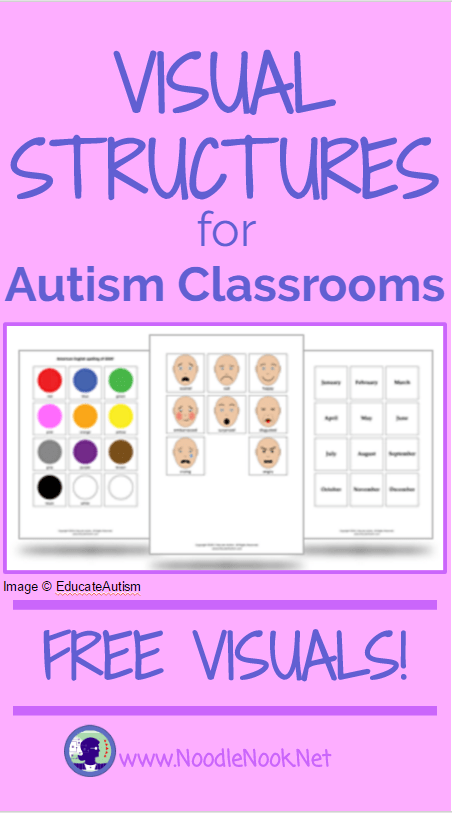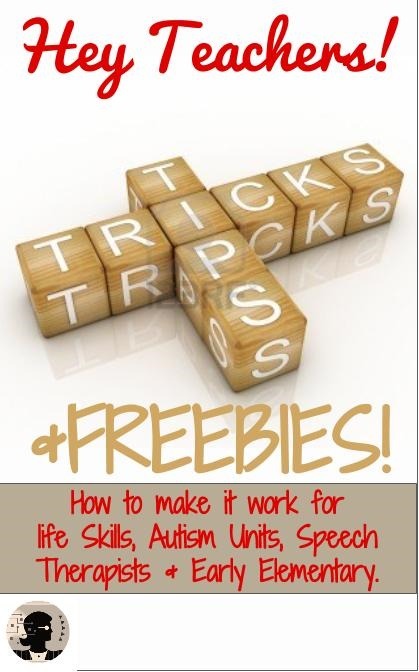Visual Structure for Autism Classrooms
Visual Structure is a pillar of structured classrooms… and I have walked into Autism classrooms where teachers have told me that they didn’t have visuals because their students didn’t need it.
I don’t know about you guys, but I need visual structure to be successful, why wouldn’t our students?
What is Visual Structure?
Are visual supports different from visual structure? A little. Think about visual structure as a great compliment to the physical structure that we talked about last week (check out that post here). You’ve gone the extra mile to make sure you have great instructional areas in your room, a room that lends itself to the routine and procedures you are putting into place, areas for students to take a break and transition… but that is not enough. Visuals will help students who struggle with using language or processing multi-step tasks the supports they need to be successful.
[tweetthis]Visual Structure for defining activities and space, Visual Support for aiding in communication. There is a difference. #autismspeaks[/tweetthis]
Visual Supports, on the other hand, are there to help students interact socially, use language, or communicate with others. Check out this old post featuring FREE communication systems.
So, let’s look at some ways we can use visual structure for autism classrooms.
Visual Structure with Task Analysis
Processing multi-step directions is very difficult for students in Autism Classrooms and also for students with multiple disabilities who have a hard time with oral language or written instructions. Using visuals to break down a task or behavior can be a great way to help a student learn and master the steps in a sequence. A great example is washing hands. Breaking that down into steps makes it more ‘teachable’ for us, and the supports make it more ‘doable’ for students. We, as the staff, can also have a visual aid to help us teach each part of the steps in the sequence.
Now you are probably wondering, where should I put these in my classroom. If you are using these to break down a complex activity into small steps you will want to have them where the tough activity takes place. When it is time to use the support, here are some pointers:
- Read each step aloud while pointing to the action as the child completes it.
- Be sure you are using visuals that are clear and uncluttered.
- Try out using the steps before you use it with students.
- Supports aren’t forever… remove supports as a student masters steps.
- Share supports with other teachers and parents for consistency.
Visual Structure to Support Physical Structure
When we define the space in our classroom and make places for certain activities it becomes important to add visuals so students (and staff) all know:
- Where to find things,
- Where things belong,
- And what happens where.
Labeling things and areas helps to give more meaning to the physical structure you worked so hard to define. Pay special attention to text size, paper/label color, and using meaningful words in conjunction with images.
When areas are designated for a very specific purpose (like a cool down area or a sensory zone) you can be very particular with your visual structures how you get into the area, when you get out, and what behaviors are appropriate in the space. You will also want to add visual structures to work system spaces so students know how to work, how to transition, and how to behave.
Remember, it is not enough to have great physical space and awesome visuals to go with them… you have to be very mindful how you teach students to reference the visual and use the space. Seems like a no-brainer, but the visuals alone are not enough.
Visual Structure to Support Instruction
During instruction, you will also want to include visuals that help the student to be successful. If you are working with math you may have a visual to use so a student is successful with their calculator, or using a number line, or even play a math game. The added bonus is those visuals will allow you to work on a target skill not just a repeatable process (like working on the target skill of addition, not the repeatable process of using a number line).
Those supports make a difference… so be sure you have them and that they are meaningful and useful.
[tweetthis]FREE Visuals for Autism Classrooms- Yeah!! #autismspeaks[/tweetthis]
Visuals- Where do I Find Them?
Are you looking for some great freebies? I got them for you. Check out the University of Indiana’s site where they have several visual supports ready to go including voices on the bus, bathroom supports, and picture of work systems and their visuals.
Visual Aids for Learning has some very cute visuals you can use for travel, emotions, and behavior. There are stand alone images as well as sequences. Adjust the number of icons to the needs of your student.
Educate Autism has several visuals that you can customize to suit your needs. And lots of these will be helpful as visual supports and classroom activities. They also have worksheets and datasheets FREE!
Finally, Practical Autism Resources has over 100 free printables you can use for visual structure in your autism classrooms. There is a lot, but it’s worth the digging.
Oh… and don’t forget the visually supported materials in my TeachersPayTeachers Store. They are awesome!
Visual Structure for Autism Classrooms
Bottom line is you absolutely need visuals in your autism classroom. You need them to define the space along with the physical structure, to break down an activity into small steps, and to support your instruction.



